A Better Sense of Place
2015 September 3 (Thu)
Late summer fruits and flowers
It's looking like the hot summer drought has ended here. As the sun is moving closer to equinox, temperatures are now only going up to about 92°F. Many plants are doing better after some rain showers last week gave them water to drink. We even had a pretty good cold front come through. Fall is coming, so I figured it's a good time to focus on all the fruit and flowers around the yard to make me feel like my efforts didn't all end in failure this summer.
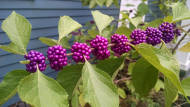 The two oldest American beautyberries by the front porch have gotten big. They are covered in bright purple berries. Already, I've seen some mockingbirds eating them. It's usually the robins who eat them and only in a couple months from now. I'm going to prune them back in late winter to see how well they take to it. They don't have a whole lot of room left to grow into where they are.
The two oldest American beautyberries by the front porch have gotten big. They are covered in bright purple berries. Already, I've seen some mockingbirds eating them. It's usually the robins who eat them and only in a couple months from now. I'm going to prune them back in late winter to see how well they take to it. They don't have a whole lot of room left to grow into where they are.
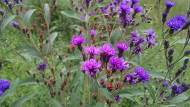 I'm not sure where this ironweed came from. Last winter, I moved it from the grass to my new front bed. I also spread some seeds around and now have 3 established. Fall seems to be the season for purple.
I'm not sure where this ironweed came from. Last winter, I moved it from the grass to my new front bed. I also spread some seeds around and now have 3 established. Fall seems to be the season for purple.
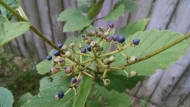 I planted this new arrowwood viburnum just as my original one was finishing flowering in the spring, so they didn't get to cross-pollinate much, a requirement of the species to produce fruit. But since the newer one flowered later, it did get a bit pregnant. These berries are the result. They are now starting to mature, turning a dark purple.
I planted this new arrowwood viburnum just as my original one was finishing flowering in the spring, so they didn't get to cross-pollinate much, a requirement of the species to produce fruit. But since the newer one flowered later, it did get a bit pregnant. These berries are the result. They are now starting to mature, turning a dark purple.
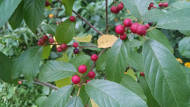 The Carolina buckthorn that gets more shade is loaded with red berries. I'll be moving the one in the front yard closer to this one in the winter. They'll be able to have play dates.
The Carolina buckthorn that gets more shade is loaded with red berries. I'll be moving the one in the front yard closer to this one in the winter. They'll be able to have play dates.
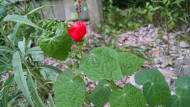 The Turk's cap is reliably flowering again, with flowers like Mona Lisa's smile: are they about to open or about to close? Neither, of course. They're just weird like that.
The Turk's cap is reliably flowering again, with flowers like Mona Lisa's smile: are they about to open or about to close? Neither, of course. They're just weird like that.
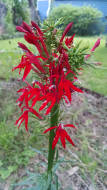 This is a new cardinal flower that just started blooming this week. I doubt it's going to get enough sun where I planted it, but it should at least get enough water, being in the rain garden.
This is a new cardinal flower that just started blooming this week. I doubt it's going to get enough sun where I planted it, but it should at least get enough water, being in the rain garden.
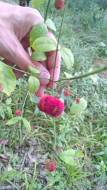 This fuzzy picture is of the strawberry bush. I couldn't get my camera to focus on it, so I held it with my hand. The little seed casings are starting to pop open.
This fuzzy picture is of the strawberry bush. I couldn't get my camera to focus on it, so I held it with my hand. The little seed casings are starting to pop open.
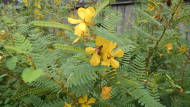 The partridge pea is still going strong. Bees, both European honey and domestic, are all over them. I've also seen some cloudless sulphur butterflies (Phoebis sennae) laying eggs on them. The back alley is a wall of this stuff. There's going to be a lot of seeds to share, as long as everyone's ok with Texas genetics. (They flower earlier, it turns out.)
The partridge pea is still going strong. Bees, both European honey and domestic, are all over them. I've also seen some cloudless sulphur butterflies (Phoebis sennae) laying eggs on them. The back alley is a wall of this stuff. There's going to be a lot of seeds to share, as long as everyone's ok with Texas genetics. (They flower earlier, it turns out.)
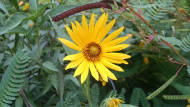 The maximilian sunflower is tucked away inside the partridge pea. It's not getting a lot of action as bees seem to favor the latter. Also, having the same color of flower, it's easy to miss.
The maximilian sunflower is tucked away inside the partridge pea. It's not getting a lot of action as bees seem to favor the latter. Also, having the same color of flower, it's easy to miss.
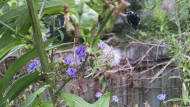 The exceptionally tall woodland lettuce — about 12 feet — are visited by lots of bees, wasps, and miscellaneous flies. It was also hard to get the camera to focus on these, but I managed to get a bee in mid-flight. I'm sure the more conventionally minded neighbors hate these as the leaves look "trashy", the flowers are tiny, and their height is so commanding.
The exceptionally tall woodland lettuce — about 12 feet — are visited by lots of bees, wasps, and miscellaneous flies. It was also hard to get the camera to focus on these, but I managed to get a bee in mid-flight. I'm sure the more conventionally minded neighbors hate these as the leaves look "trashy", the flowers are tiny, and their height is so commanding.
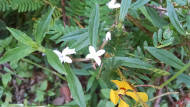 And down low are some Virginia buttonweed, a native plant that the turfgrass purists despise because of its "invasive" nature. But I say if it can hold its own against a plant as devastating and useless as turfgrass, it's a hero.
And down low are some Virginia buttonweed, a native plant that the turfgrass purists despise because of its "invasive" nature. But I say if it can hold its own against a plant as devastating and useless as turfgrass, it's a hero.
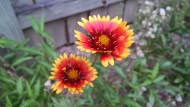 The last picture I took is of a single Indian blanket plant at the alley entrance. This may be the last plant I've got of this species. I don't think it's going to be sticking around this Baton Rouge yard.
The last picture I took is of a single Indian blanket plant at the alley entrance. This may be the last plant I've got of this species. I don't think it's going to be sticking around this Baton Rouge yard.
In other news, I dug up the Japanese snowball and replaced it with a pawpaw. The sassafras growing tips have died, but there are a few healthy-looking offshoots; I'm not sure yet how this will weaken it should it mature. Finally, I've been working out a new set of plans for the fall planting season. More on that later.


